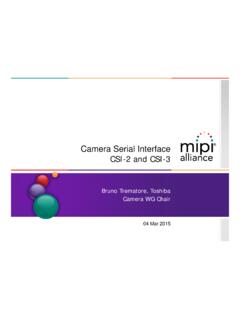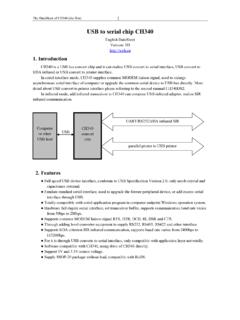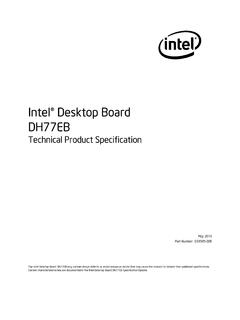Transcription of Evolving CSI-2 Speci˜ cation - MIPI Alliance
1 445 Hoes Lane Piscataway, NJ 08854 USA The bandwidths of today s host processor-to-camera sensor interfaces are being pushed to their limits by the demand for higher image resolution, greater color depth and faster frame rates. But more bandwidth is simply not enough for designers with performance targets that span multiple product generations. The mobile industry needs a standard, robust, scalable, low-power, high-speed, cost e ective camera interface that supports a wide range of imaging solutions for mobile devices. The MIPI Alliance Camera Working Group has created a clear design path that is su ciently exible to resolve not just today s bandwidth challenge but features and functionality challenges of an industry that manufactures more than a billion handsets each year for a wide spectrum of users, applications and cost points.
2 MIPI CSI-2 and MIPI CSI-3 are the successors of the original MIPI camera interface standard, and both standards continue to evolve. Both are highly capable architectures that give designers, manufacturers and ultimately consumers more options and greater value while maintaining the advantages of standard BRIEFE volving CSI-2 Speci cationSensor fusion and shutter lag Compatible with I2C interface widely used in camera subsystems. Sensor exibility: Design into systems with ALS, IR, Gyro, Presence, Accelerometer and MEMS sensors. Real-time sensor con guration and adjustment. Fast AF: Real-time feedback allows quick lens con guration. Never miss a and subtler colors Improved data transfer rate (up to 4X) enables increased color depth (up to factor) and higher resolutions for crisper battery life Lowest energy per bit allows most e cient operation in the industry.
3 Robust operation minimizes processor video resolution Higher bandwidth enables frame resolutions of 1080p, 4k, 8k and beyond and more stable images including 240 FPS and system cost Lower pin count. Longer wires allow more exible system integration. Low EMI facilitates routing across the screen. C-PHY solution provides embedded clock and data enabling about e ective bandwidth increase over channel toggle rate that reduces the number of PHY SummaryThe latest Camera Serial interface 2 Speci cation ( CSI-2 ) o ers higher interface bandwidth and greater channel layout exibility than its predecessor. It introduces C-PHYSM , a new PHY that MIPI Alliance released in September 2014, as well as support for the previous version s D-PHYSM interface .
4 Both PHY options improve skew tolerance and provide higher data rates. Both are serial interfaces that address many of the problems of parallel interfaces, which consume relatively large amounts of power, are di cult to expand and can be Hoes Lane Piscataway, NJ 08854 USA 4K @ 30 FPS AND 12 BPPREQUIRED MIPI SPECS (IPs)PHY PINS[ CSI-2 ] [D-PHY][ CSI-2 ] [C-PHY]63 CHANNELR AT GspsREQUIRED GbpsVARIABLE LINK RATEYe sYe sCONTROL INTERFACEI2CI2 CInfotainment/TelematicsHubRear-seatInfo tainment Di erent forms of SerDes for long length in-car connectivity. High speed cable assemblies and their topologies for audio, video, and control signals vary across automobile manufacturers and models.
5 MIPI interfaces originally intended for small form-factor mobile terminals have been modestly increased to support longer trace lengths. MIPI interfaces may be converted to/ from these high speed transports in bridge chips when lengths exceed MIPI speci cation DiagramCameraMIPI CSIS ensorMIPI I3 CDisplayMIPI DSIG augeMIPI DSIC onnectivity (LTE, Wi-Fi, BT)MIPI DigRF, MIPI RFFES torageUFS/MIPI UniPort-MCSI-2 protocol contains transport and application layers, and natively supports D-PHY & C-PHYCSI-3 application stack connects to UniPro transport layer, which in turn bolts onto M-PHYA pplicationsTransportPHYC-PHYD-PHYCSI-2 CSI-3 Uni-ProM-PHYCSI-3 At-a-GlanceFEATUREDESCRIPTIONP hysical InterfaceLanesSignalling Rate (Data Rate)
6 Virtual ChannelsControlsTransmissionInterruptsCo lor Spaces and data formatsCommand latencyCommand bandwidthM-PHY to 4Up to ( ) GB/s per laneUp to 32In-bandPack basedIn-bandYUV, RAW, RGB, JPEG< 1 usTypically 1 Gb/sCSI-2D-PHYCSI-2C-PHYI mageSensorApplicationProcessorEffective (usable) BW: 5 Gbps12C Compatible 2-wire Camera ControlPin compatible coexistence supports CSI-2 over combo C/D-PHY solutionsPeriodic clockDataGross BW: 5 GbpsChannel Rate: GbpsCSI-2 RXD-PHYRX(6-pins)D-PHYTX(6-pins)CSI-2TX1 8 pin Forwarded Sync Clock SoCFixed Configurations Gbpsx25 Gbpsx25 Gbpsx410 Gbps18 pin Embedded Clock and Data SoCAll Configurations SupportedAFGyroOISF lashMEMSI mageSensorApplicationProcessorEffective (usable) BW: Gbps12C Compatible 2-wire Camera Gspsembedded clock and dataGross BW: GbpsChannel Rate.
7 GspsCSI-2 RXC-PHYRX(6-pins)C-PHYTX(6-pins) CSI-2 TXAFGyroOISF lashMEMSD ATCDCDCDCDCDCDD ATCLKD ATCLKD ATCLKD ATD ATAPPA x8 D-PHY port may be supported by allotting 16 pinsfor data and 2 pins for clock providing 20 x6 C-PHY port may be supported using 6 trios providing Aggregate BW 15 GbpsTotal Aggregate BW GbpsAPPU sing D-PHY maintains compatibility with earlier versions of the speci cation and lets vendors leverage their existing product development infrastructure. C-PHY requires a minimum of three pins instead of four and provides pin-wise backwards compatibility with D-PHY. Designers can implement standalone C-PHY, D-PHY or combo C/D-PHY options to ensure longer-term design CSI-2 protocol contains transport and application layers and natively supports C-PHY, D-PHY, or combo C/D-PHY.
8 The camera control interface for both physical layer options is bi-directional and compatible with the I2C standard. The CSI-2 Speci cation de nes standard data transmission and control interfaces between the camera as a peripheral device and a host processor, which is typically a baseband, application engine. The table below illustrates optimal MIPI CSI and PHY con gurations for popular 4K imaging format:TECHNOLOGY BRIEFE volving CSI-2 Speci cationCSI-2 over D-PHY and C-PHYD-PHY as used in CSI-2 is a unidirectional di erential interface with one 2-wire forwarded clock lane and one or more 2-wire data lanes. The updated D-PHY speci cation , , introduces lane-based data skew control in the receiver to achieve a peak transmission rate of Gbps/lane or 10 Gbps over 4 lanes, compared to the peak transmission rate of Gbps/lane or 6 Gbps over 4 lanes.
9 C-PHY consists of one or more unidirectional 3-wire serial data lanes or trios , each with its own embedded clock. The physical layer of C-PHY interface is de ned by the MIPI Alliance Speci cation for C-PHY. MIPI C-PHY uses 3-phase symbol encoding of about bits per symbol on a trio where each trio operating at Gsps provides an equivalent of Gbps per lane. Three trios operating at the C-PHY rate of Gsps provides Gbps over a 9-wire interface that can be shared, if desired, with the MIPI D-PHY interface . CSI-2 over C/D-PHY imaging interface does not limit the number of lanes per link. Transmission rate linearly scales with the number of lanes for both C-PHY and D-PHY.
10 The Figure below illustrates the connections between a CSI-2 Image Sensor transmitter and an Application Processor receiver using 6-pin C/D-PHYs, which are typically used on Mobile s CSI-2 is currently the mostwidely adopted camera interfacein mobile At-a- Glance C-PHY , D-PHY or combo C/D-PHY possible 4 Virtual Channels, 64 Data Types RGB, YUV, RAW, JPEG Formats Embedded Data Line based transmission Easy implementation Low gate count Matched data rates for sensor and link CRC/ECC for payload and header protectionGbps = Giga bits per second | Gsps = Giga symbols per second445 Hoes Lane Piscataway, NJ 08854 USA RATE GBPS EVOLUTION OF CSI-2 PERFORMANCE CAPABILITIESC S I 2 V 1.







